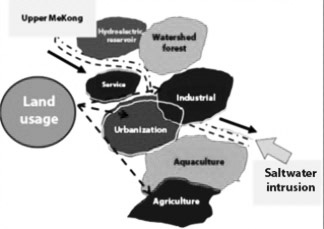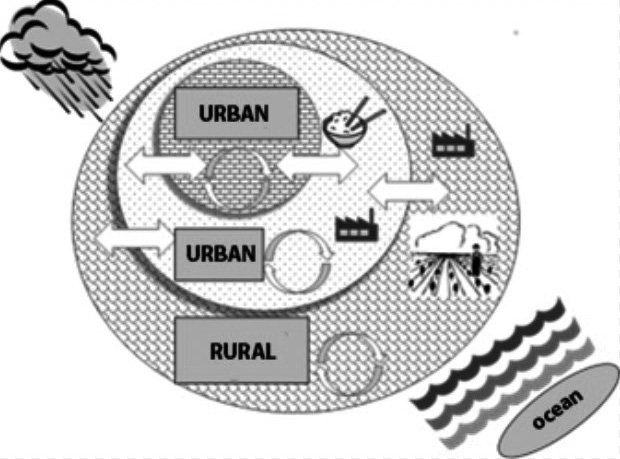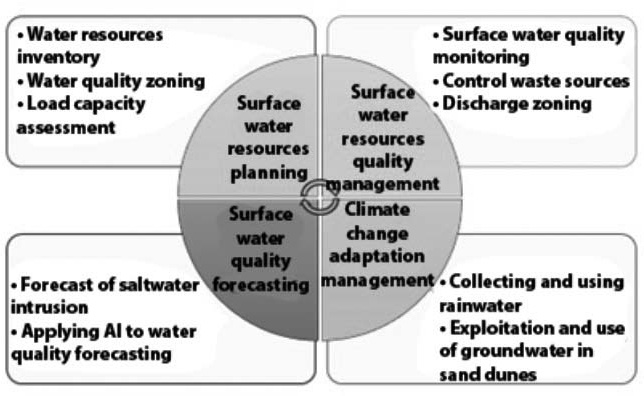

23/07/2025
Abstract
The closed-loop water management model is a system for managing water resources through reuse and circulation, aimed at minimizing loss, pollution, and waste (Grigg, 2008; GWP, 2000). At the same time, it helps address water scarcity issues in Ben Tre amid increasingly complex and unpredictable climate change impacts. Therefore, it is essential to orient water resource management solutions for surface water along both short-term and long-term routes (Butterworth et al., 2010). By using synthesizing, analyzing, and inheritinginformation and data from various sources, surveys, and monitoring activities of the province to utilize this model to address Ben Tre’s current problems. This model enables the spatial utilization and exploitation of available water components to meet three requirements: total water volume, the capacity for extraction and use across multiple needs, and quality assurance of water sources for each usage purpose (domestic usage, industrial production, agricultural production, and aquaculture)(Biswas, 2008; Srinivasan et al., 2012). Therefore, in addition to reviewing, evaluating, and analyzing water mangagement related infrastructure systems (such as hydraulic infrastructure), salinity monitoring and warning infrastructure, and updating irrigation and water resource planning for each region, it is essential to propose an integrated surface water resource management model for Ben Tre, along with the necessary tools for effective practical implementation.
Keywords: Ben Tre, closed-loop water management system, climate change. JEL Classifications: Q25, Q54, Q55.
Received: 26th May 2025; Revised: 12th June 2025; Accepted: 27th June 2025.
1. INTRODUCTION
Surface water resources (SWR) in Ben Tre Province of Vietnam hold exceptional significance for the province’s livelihoods, production, and environment. They provide water for treatment plants that supply domestic, industrial, and service sectors; irrigation for agricultural production; water for livestock and aquaculture. These resources are also a key factor in promoting inland waterway transportation and the development of garden-based eco-tourism. Moreover, they serve as habitats for aquatic species and play an essential role in maintaining the ecological health of both aquatic and terrestrial ecosystems.
SWR in Ben Tre Province mostly come from Tien river, which branches to four sub-river including My Tho, Ba Lai, Ham Luong and Co Chien river. This kind of branches represent a fan-like arrangement of rivers distribution, and embracing the three strips of islets that make up Ben Tre. All of them flow in a northwest– southeast direction and empty into the sea. These four rivers play a very important role in the economic and cultural life of the province's residents.
Due to the impact of climate change, during the dry season, saltwater from the East Sea increasingly intrudes deeper inland, affecting more than two-thirds of the province's total area. This salinization contaminates most rivers, canals, and water sources, leading to degradation and pollution that severely affect people's lives, especially their access to clean water. Groundwater at the depth between 40 - 120 meters and over 350 – 450 meters in Ben Tre is only found in a few communes located in the central area of Thanh Phu District and part of northern Chau Thanh District. However, the water quality is only marginally suitable for domestic use, as salinity levels range from 0,35 to 0,8‰, while the Ministry of Health's standard is just 0,3‰. According to the Ben Tre Center for Rural Clean Water and Environmental Sanitation, due to climate change, the province is currently facing a severe shortage of freshwater. Moreover, during the dry season, saltwater intrudes deeper and more aggressively into inland areas, as the internal irrigation canal system remains incomplete.
From the issues outlined above, it is obvious that Ben Tre Province is currently facing, and will continue to face, significant water resource challenges. One major concern is the province’s dependence on upstream water sources, which are increasingly being exploited. Moreover, water resources in the region are unevenly distributed in both space and time, in terms of both quality and quantity, leading to water scarcity and shortages during the dry season. In addition, the exploitation and usage of water resources remain inefficient and unsustainable, resulting in the depletion of water supplies, while water use efficiency is still quite low. Meanwhile, demand for water continues to increase, even as water sources face growing risks of pollution, degradation, scarcity, and exhaustion. Therefore, it is essential to conduct research and assessments on the current status of surface water exploitation and use across the province. Based on these findings, more focus and appropriate solutions should be proposed to manage and utilize water resources. These solutions should be under a closed-loop water management model due to current hydraulic systems and managing schemes of the province, this model should be a better way to ensuring water security and protecting the livelihoods of local residents.
2. RESEARCH SUBJECTS AND METHODS
2.1. Research subjects: Surface water resources in Ben Tre Province of Vietnam and applying closed-loop water management model is a system for managing water resources.
2.2. Method of synthesizing and analyzing information and data: The research team collected information and data on the flow rates of major rivers in Ben Tre Province to support the water resource assessment; rainfall data provided by the meteorological and hydrological agency; data on water usage demand and the current status of surface water exploitation in Ben Tre; and legal documents issued by both the central government and Ben Tre Province regarding surface water resources.
2.3. Inheritance method: This method involves inheriting and compiling the results of previous surveys and monitoring activities related to surface water resources in the province, as well as findings from relevant research projects, scientific papers, and studies both domestic and international. These serve as a foundation for assessing water resources and proposing solutions for remediation and the rational, sustainable distribution and use of water.
3. RESULTS AND DISCUSSION
3.1. Challenges facing surface water resources in Ben Tre Province
In the course of increasingly climate change impacts in the Mekong Delta, SWR are among the most heavily affected. Freshwater areas are shrinking due to intensified saltwater intrusion, driven by rising sea levels and declining rainfall. Clean water availability is also diminishing as a result of pollution from industrial, agricultural, and domestic activities. Additionally, the total volume and flow rates of major rivers in the province have decreased due to upstream activities along the Mekong River. In addition, both the quality and quantity of SWR in general, and the available water sources in Ben Tre in particular, have been and are being increasingly affected by the processes of urbanization and industrialization. These developments have led to a growing demand for water for domestic use, services, agricultural production, and aquaculture (Figure 1).

Figure 1. Challenges to surface water resources in Ben Tre
The orientation of SWR management solutions must be implemented through both short-term and long-term roadmaps (Schreier et al., 2014; Suhardiman et al., 2015). In the long term, the adoption of an integrated water resource management approach requires a clearly defined roadmap beyond 2030, with the synchronized implementation of key policy groups. Under this roadmap, SWR in Ben Tre Province will be sustainably managed, and rationally exploited and used for each water user group. In the short period from 2025 to 2030, ensuring the availability and stability of SWR must be feasible in terms of: The total volume of water available for various uses; and the spatial coverage to meet demands in both urban areas (for domestic, industrial, and service needs) and rural areas (for domestic and agricultural production needs).
3.2. Closed-loop water management system
The proposed closed-loop water management model can be considered a suitable solution for Ben Tre Province. The principles of this model are illustrated in Figure 2.

Figure 2. Closed-loop water management system
The components of water resources and the entities (or activities) that exploit and use water in Ben Tre are viewed as part of a closed-loop, intra-provincial water cycle, including: (i) Rainwater - A component of the natural hydrological cycle, which contributes to surface runoff through rivers, canals, and streams, with a portion infiltrating geological layers to form groundwater; (ii) Surface water - One of the three main components of the water cycle. The surface runoff generated by rainfall over land use areas constitutes the SWR of the province. This is the primary source for meeting water demands in agricultural production, aquaculture, industrial activities, services, and domestic use. (iii) Groundwater - The third component of the water cycle. A large portion of rainwater, after forming surface runoff, naturally infiltrates geological layers to recharge groundwater. The groundwater zones found in the coastal sand dune areas of Ben Tre have been formed through this natural process. (iv) Seawater - A form of surface water within the natural hydrological cycle, primarily serving aquaculture activities in coastal areas.
The key point of the model lies in its approach to utilizing and exploiting the available water components distributed across space, ensuring the fulfillment of three main requirements: (i) Total water volume (availability of water resources); (ii) THe capacity to extract and use water for various needs; and (iii) Assurance of water quality for each specific use. To implement the closed-loop water management model, the essential components that must be put into practice immediately include: Recycling and reusing water sources; collecting and using rainwater; combining the exploitation of surface water and groundwater; and completing the water quality monitoring and management network.
3.2.1. The circulation and reuse of water resources
The recycling and reuse solution must be implemented for specific water users and purposes, as follows:
For urban areas (such as Ben Tre city, towns, and communes): Domestic wastewater, once treated to meet discharge standards (Category A), can be reused for irrigating parks, green spaces, and buffer zones. This solution is particularly suitable during the dry season in the Mekong Delta, when saltwater intrusion into SWR tends to intensify. Additionally, it may be considered for aquaculture activities in peri-urban areas, such as pond farming (e.g., fish, eels).
For industrial zones and clusters: Treated wastewater from food processing industries can be reused for irrigation or to supply water for green spaces within production areas. This solution is especially appropriate during hot, dry seasons with limited rainfall and increased salinity. In the long term, the Provincial People's Committee should issue mandatory regulations on water recycling and reuse in industrial production. For example, requiring closedloop systems for cooling water and reusing treated wastewater for on-site irrigation.
For rural and agricultural areas: Treated domestic wastewater can be reused for aquaculture activities combined with the cultivation of aquatic plants (such as duckweed, water spinach, or water mimosa, etc.).
3.2.2. Rainwater collection and usage
This solution has been and continues to be widely adopted around the world, as rainwater is a component of the natural water cycle, naturally clean and meeting standards for domestic water supply. Compared to highdensity urban areas (such as Ho Chi Minh City), urban areas in Ben Tre have the advantage of more available space, making it easier to implement mandatory or recommended regulations for collecting rainwater from rooftops for purposes such as: household use (e.g., car washing, garden irrigation); supplying water for urban green spaces (parks, buffer zones); and contributing to the microclimate and landscape of broader urban areas. On the other hand, rural areas affected by acid sulfate soils and limited water supply networks can benefit from rainwater as an alternative source during the dry season, when saltwater intrusion makes it difficult for rural water treatment and supply stations to operate effectively.
3.2.3. Integrated exploitation of surface water and groundwater
Surface water is the primary source for meeting water demand in Ben Tre Province. However, in recent years, the pressure on freshwater resources during the dry season has become the province’s greatest challenge, particularly in coastal districts such as Ba Tri, Binh Dai, and Thanh Phu.
Thanks to the advantage of groundwater reserves formed during the late geological period (Holocene sediments) in coastal sand dune ecosystems, the exploitation and use of groundwater is entirely appropriate to meet domestic water needs in these coastal districts. The total exploitable groundwater reserves in the sand dune areas are estimated at 4,507 m³/day in Binh Dai, 3,364 m³/day in Ba Tri, and 3,169 m³/day in Thanh Phu.
3.2.4. Strengthen and complete the water quality monitoring and management system
The water quality monitoring network is an inseparable component of the water source zoning and wastewater discharge zoning plans within the province. This element must be implemented in parallel to ensure effective surface water quality management, meeting the water use demands of the province’s three socio-economic zones and development corridors, as approved under Decision No. 1399/QĐ-TTg dated March 17, 2023, by the Prime Minister on the Planning forprovincial planning of Ben Tre Province for the period 2021–2030, with a vision to 2050.
3.3. Management plans and tools to support the implementation of the closed-loop water management model
To implement the closed-loop water management model, the research team infer:
Water source zoning and environmental zoning (strict protection zones, emission-restricted zones) must be carried out in accordance with Decision No. 1399/QD-TTg dated March 17, 2023, by the Prime Minister on the Planning of Ben Tre Province for the period 2021 - 2030, with a vision to 2050; and Decision No. 21/2017/QD-UBND by the Ben Tre Provincial People's Committee on environmental zoning for water bodies receiving wastewater within the province.
In addition, the Department of Agriculture and Environment must promptly implement the water resource inventory plan for the province, as stipulated in Decision No. 1381/QD-TTg dated August 4, 2021, by the Prime Minister, and guided by Official Dispatch No. 4464/BTNMT-TNN dated June 16, 2023, from the Department of Water Resources under the Ministry of Natural Resources and Environment (now the Ministry of Agriculture and Environment). This includes zoning for water quality, wastewater discharge, and assessing the carrying capacity of surface water bodies in accordance with Decision No. 21/2017/QD-UBND of the Ben Tre Provincial People's Committee.
At the same time, it is necessary to forecast saltwater intrusion and water quality changes due to environmental shifts and the impacts of climate change, as outlined in Plan No. 4646/KH-UBND of the Ben Tre Provincial People's Committee and Plan No. 4072/ KH-STNMT of the Department of Natural Resources and Environment (now the Department of Agriculture and Environment) on managing and ensuring water security and freshwater supply in response to climate change for the period 2020 - 2030.

Figure 3. Management instruments and planning frameworks for supporting the closed-loop water management model in Ben Tre
The closed-loop water management model is only implementable when implemented in parallel with water resource management plans and tools across Ben Tre Province (Figure 3).
4. CONCLUSION
Surface water resources are both a critical input and a limiting factor in the socio-economic development of the entire Mekong Delta region in general, and Ben Tre Province in particular. In Ben Tre, the pressure on both the quantity and quality of SWR consistently poses challenges for effective water resource management. As for Ben Tre’s SWR is currently heavily contaminated by saltwater, the cost of technology to ensure the model works will be highly increasing. In addition, many communities and local stakeholders have limited understanding of water reuse, and water management responsibilities are often divided among multiple departments (agriculture, environment, construction, etc.). These challenges make up for the lack of coordination in addresing plans and informing roadmaps to the locals.
An integrated water resource management approach is a long-term solution that must be implemented with a forward-looking roadmap (beyond 2030, with a vision to 2050) to ensure the sustainable exploitation and use of water resources. Between 2025 and 2030, the implementation of a closed-loop water management model should be prioritized to align with Ben Tre’s socio-economic development plans.
The proposed model integrates rainwater harvesting, wastewater reuse, and discharge source control, while also applying artificial intelligence to forecast water quality and saltwater intrusion in the province. These components will be incorporated into a centralized water resource database management system, contributing to the enhancement and long-term preservation of water quality and reserves in Ben Tre.
Võ Lê Phú1, Lâm Văn Tân2, Tôn Thất Lãng3
1Ho Chi Minh City University of Technology
2Department of Science and Technology of Ben Tre Province
3Ho Chi Minh City University of Natural Resources and Environment
(Source: The article was published on the Environment Magazine by English No. II/2025)
REFERENCES
1. Biswas, A. K. (2008). Integrated Water Resources Management: Is It Working. International Journal of Water Resources Development, 24, 5-22.
2. Butterworth, J., Warner, J., Moriarty, P., Smits, S., & Batchelor, C. (2010). Finding Practical Approaches to Integrated Water Resources Management. Water Alternatives, 68–81.
3. Grigg, N. S. (2008). Integrated water resources management: balancing view sand improving practice. Water International, 33(3), 279-292.
4. GWP. (2000). Integrated Water Resources Management. Global Water Partnership, Stockholm.
5. Schreier, H., Kurian, M., & Ardakanian, R. (2014). Integrated Water Resources Management: A Practical Solution to Address Complexity by Employing the Nexus Approach. Working Paper - No.2.
6. Srinivasan, V., Palaniappan, M., Akudago, J., Cohen, M., & Smith, J. C. (2012). Multiple-Use Water Services (MUS): Recommendations for a Robust and Sustainable Approach. Pacific Institute, California.
7. Suhardiman, D., Clement, F., & Bharati, L. (2015). Integrated water resources management in Nepal: key stakeholders’ perceptions and lessons learned. International Journal of Water Resources Development,31, 284-300.